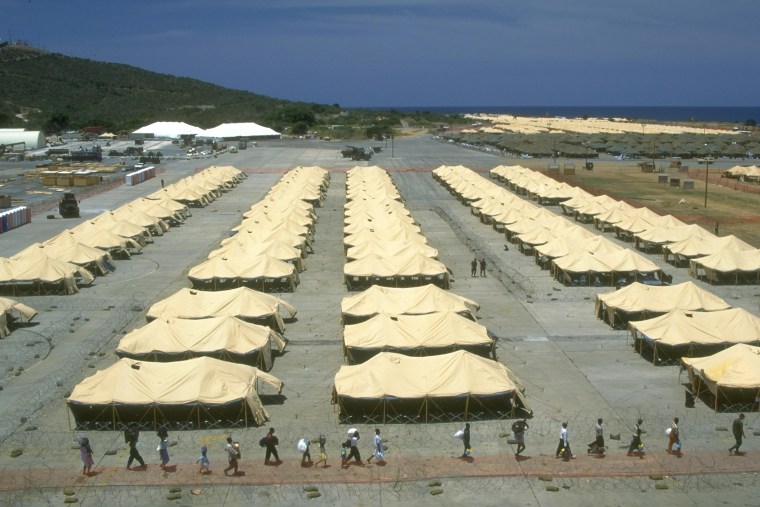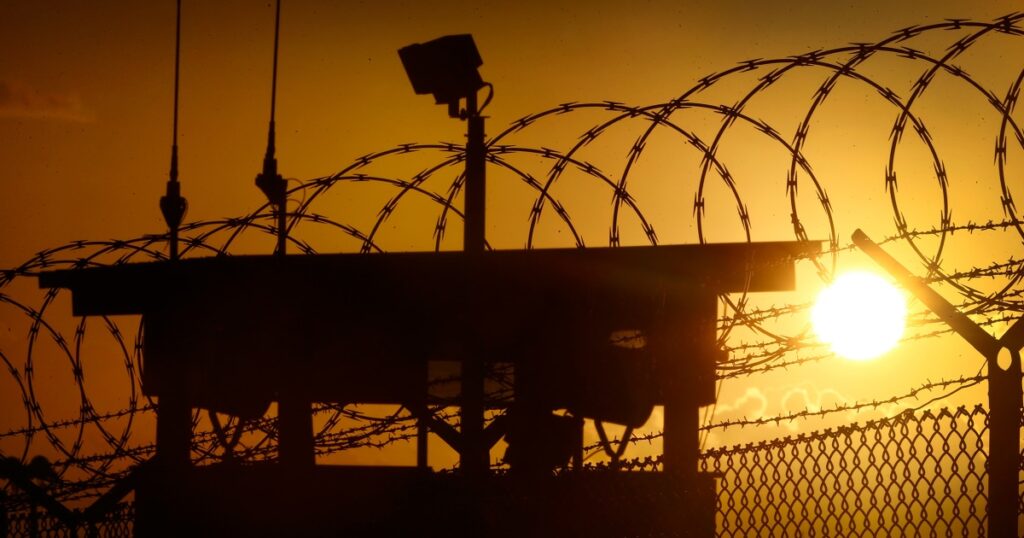WASHINGTON — The Trump administration’s decision this week to detain some immigrants at the detention facility at the U.S. Naval Base at Guantanamo Bay that was created after 9/11 for holding prisoners accused of terrorism is the beginning of a broader plan to hold more immigrants in the high-security prison, rather than the previously constructed low-level detention space for immigrants, six people familiar with the plans told NBC News.
The plan is to expand the prison so that immigrants can be held not only inside the prison facility but also in tent camps surrounded by fencing that have not been completely built, according to three officials familiar with the planning. One person familiar with the planning said part of the tent camps has been built.
Trump announced last Wednesday that he would direct the Defense Department and the Department of Homeland Security to ready Guantanamo to detain 30,000 migrants. The first flight of immigrants arrived at Guantanamo on Tuesday. A senior White House official and the person familiar with the plans said that among the ten immigrants on that flight were suspected members of the Tren de Aragua gang who are being held at the detention facility also used to detain suspected terrorists.
It is not clear how long the administration intends to imprison immigrants who are moved into the detention facility, which has been used to hold detainees accused of terrorism since 2002, or under what specific legal authorities. On his first day in office Trump moved to designate certain drug cartels and gangs, such as Tren de Aragua and MS-13, as foreign terrorist organizations.
A spokesperson for the Department of Homeland Security declined to comment. The White House did not respond to requests for further comment.
When announcing plans to hold 30,000 immigrants on the naval base, Trump indicated there could be longer-term detainments there for some immigrants. “Some of them are so bad, we don’t even trust the countries to hold them because we don’t want them coming back,” Trump said at the time. “So we’re going to send them out to Guantanamo.”
A former senior ICE official said the agency had under 10,000 detainees considered to be a high risk to public safety at the time the Biden administration left office, raising questions about what immigrants would be sent to fill a 30,000 bed facility.
In the past, the U.S. has held migrants on a part of the sprawling naval base’s campus that is completely separate from the detention facility used to imprison detainees accused of terrorism. Known as the Migrant Operation Center, or MOC, it has been used to temporarily hold migrants interdicted at sea. Two Biden administration officials who recently left the Department of Homeland Security told NBC News that the MOC at Guantanamo can only hold 200 people and is in need of repair. Those officials say a Biden-era estimate priced needed upgrades, which would not expand capacity beyond 200 beds, at $15 million.

Rather than using the MOC, the majority of the immigrants sent to Guantanamo under Trump’s plan are expected to be held temporarily in the tent camps near the prison before being transported to their home country or a third-party country that’s agreed to take them, according to the people familiar with the plan. But those considered by the administration to be the most dangerous criminals are expected be held separately at the facility used to hold detainees accused of terrorism, though the immigrants would not be housed directly with the 15 detainees that remain there, three officials familiar with the planning said. It is not clear how or to what extent immigrants in tents will be separated from those inside the prison.
Lawyers in the Trump administration were still reviewing potential legal problems with sending immigrants to Guantanamo as recently as Saturday, according to two Homeland Security Department officials.
ICE has not provided details about how immigrants are being designated as members of cartels or gangs. Some of them either have a suspected affiliation with or have been convicted of crimes affiliated with a cartel or gang.
Because of longstanding federal court settlements, immigration detention in the U.S. is not meant to be punitive, like a jail sentence, and must adhere to certain humanitarian conditions, particularly if minors are held there. Court orders also prevent Immigration and Customs Enforcement from holding immigrants indefinitely, which has been interpreted to mean longer than six months if there is not a clear route to deportation. Immigrant rights groups could potentially challenge the Trump administration in court if they can show conditions in Guantanamo violate previous court orders.
It is not clear if the Trump administration might seek to hold immigrants convicted of serious crimes or suspected to be part of cartels or gangs under a different designation than the one under which the U.S. holds those who have violated civil immigration laws.
The designation of MS-13 and Tren de Aragua as foreign terrorist organizations, if finalized, would expand the administration’s powers to target known members of the groups and anyone who aids or collaborates with them. It allows the federal government to prosecute anyone who supports the groups in any way on charges of providing material support to terrorists. It also allows the administration to put suspected members of the groups on a watchlist so they could be arrested, stopped from flying into the U.S., or blocked from crossing the U.S. border.
Homeland Security Secretary Kristi Noem said Sunday in an interview with “Meet the Press” moderator Kristen Welker that “due process will be followed” for immigrants detained at Guantanamo. She also said it is “not the plan” for immigrants to be detained there indefinitely, but did not rule it out.
The detention facility at Guantanamo Bay has been used to hold detainees accused of terrorism since 2002. At its peak, the detention facility held hundreds of suspected terrorists. Several of those who are left in the facility are eligible to be transferred out, but that is not expected to take place while Trump is in office. Some of the current detainees, such as alleged 9/11 mastermind Khalid Sheikh Mohammad, are deemed too dangerous to transfer out of U.S. custody.
Multiple presidents have tried to close the detention facility at Guantanamo but have failed to do so, largely due to a ban on bringing any of the detainees to prisons in the U.S. that Congress passed in 2015.
U.S. troops have been involved in operations at the detention facility at Guantanamo that holds detainees accused of terrorism and could be similarly involved if any immigrants are also held there.
Where they are housed inside Guantanamo could affect their legal rights, said John Yoo, a deputy assistant attorney general in the Justice Department during the George W. Bush administration. Yoo said there are outstanding questions about how any of the immigrants held at Guantanamo would have the ability to appeal their detention.
Those held in the detention facility that houses detainees accused of terrorism, Yoo said, may be able to appeal through the military commissions at Guantanamo, while individuals who have previously been held in the Migrant Operations Center had the same rights as anyone in a regular ICE facility, where they cannot be held indefinitely.
“Some of the hard questions that are going to come up for the administration are going to be, ‘Suppose that you have people who work for these drug cartels who are not illegal aliens? Would they be sent to Guantanamo too? Would the military be allowed to arrest them as well? Are we going to allow the military to arrest people in the United States at all?’” Yoo said.
“I don’t think these are questions the Trump administration will want to test in court,” Yoo said. “We had to figure all this out 20 years ago and I was hoping it would not come up again.”
Trump’s announcement of a plan to send immigrants to Guantanamo surprised officials across the Defense and Homeland Security Departments at the time and set off a scramble to sort out the complicated and pricey logistics of carrying out his directive, according to multiple officials in both agencies.
Creating a space that could hold 30,000 immigrants at Guantanamo Bay would more than double ICE’s current capacity to detain immigrants. According to a DHS official, ICE detention facilities — which nationwide have about 40,000 beds — were at 109% capacity as of Tuesday morning.
But it could be costly to do, even before the added expense of transporting immigrants to Guantanamo.
“It’s going to be very expensive and logistically challenging to do anything down there,” a former senior ICE official told NBC News.
ICE is already facing a budget shortfall.
U.S. law also allows immigrants the right to counsel. Though the Trump administration recently issued a stop work order for contracts that provided immigrants with “know your rights” presentations in ICE detention, they may still request a meeting with a lawyer and lawyers would have to be allowed to enter the facility.
This article was originally published by a www.nbcnews.com . Read the Original article here. .

